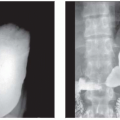Introduction to Peritoneum and Mesentery
Michael P. Federle, MD, FACR
Embryology and Relevant Anatomy
The fetal gut is suspended between the anterior and posterior abdominal walls by the ventral and dorsal mesenteries, which separate to enclose the developing alimentary tube. Important viscera develop within the mesentery of the caudal part of the foregut, such as the liver, pancreas, spleen, and biliary tree.
The various mesenteries either regress or elongate. The dorsal mesentery lengthens with the progressive elongation of the small intestine. The ventral mesentery resorbs, which allows communication between the right and left sides of the peritoneal cavity in adults.
Variations in the complex rotation, fusion, growth, and resorption of mesenteries and the viscera that develop within them result in common variations in peritoneal and retroperitoneal spaces in adults, with clinical manifestations such as internal hernias.
All peritoneal recesses potentially communicate, although adhesions and other pathologic processes may seal off loculated collections of fluid, such as infected or malignant ascites.
Peritoneal Cavity
The abdominal cavity contains all of the abdominal viscera, both intra- and retroperitoneal, and is not synonymous with the peritoneal cavity. The abdominal cavity is limited by the abdominal wall muscles, the diaphragm, and (arbitrarily) the pelvic brim.
The peritoneal cavity is a potential space within the abdomen that lies between the visceral and parietal peritoneum. It usually contains only a small amount of fluid (for lubrication).
The peritoneal cavity is comprised mostly of the greater sac (or general peritoneal cavity). The lesser sac (omental bursa) communicates with the greater sac through the epiploic foramen (of Winslow) and is bounded in front by the caudate lobe, stomach, and greater omentum, and in back by the pancreas and left kidney. To the left, the lesser sac is bound by the splenorenal and gastrosplenic ligaments, and on the right by the lesser omentum and epiploic foramen.
While the lesser sac is in communication with the rest of the peritoneal cavity, ascites usually does not enter into it readily. Lesser sac fluid collections usually result from a local source (e.g., pancreatitis or perforated gastric ulcer), or from generalized infection or tumor (e.g., infectious or malignant ascites).
Peritoneum
The peritoneum is a thin serous membrane consisting of a single layer of squamous epithelium (mesothelium). The parietal peritoneum lines the abdominal wall and contains nerves to the adjacent abdominal wall, making it sensitive to pain with sharp localization. Intraabdominal disease processes that result in sharply localized pain or tenderness have generally progressed to perforation or other sources of peritoneal irritation. The visceral peritoneum (serosa) lines the abdominal organs. Its pain receptors are sensitive only to stretching (e.g., from distended bowel) and result in poor localization of the source of pain.
Mesentery
Each mesentery is a double layer of peritoneum that encloses an organ and connects it to the abdominal wall. These include the small bowel mesentery and the transverse and sigmoid mesocolons.
The mesentery is covered on both sides by mesothelium and has a core of loose connective tissue containing fat, lymph nodes, blood vessels, and nerves, which pass to and from viscera.
Most mobile parts of the gut have a mesentery, while the ascending and descending colon and some parts of the duodenum are considered retroperitoneal, as they are covered only on their anterior surfaces.
The root of the mesentery attaches to the posterior abdominal wall. Processes that originate in retroperitoneal organs, such as pancreatitis, may involve intraperitoneal organs by easily spreading through the “subperitoneal space” via the mesenteries.
Omentum
An omentum is a multilayered fold of peritoneum that extends from the stomach to adjacent organs. The lesser omentum joins the lesser curve of the stomach and proximal duodenum to the liver. The hepatogastric and hepatoduodenal ligaments comprise the lesser omentum and carry or contain the bile duct, portal vein, hepatic artery, and important lymph nodes.
The greater omentum is a 4-layered fold of peritoneum that hangs from the greater curve of the stomach like an apron, covering the transverse colon and much of the small intestine. The greater omentum contains variable amounts of fat and abundant lymph nodes. It is mobile and can fill gaps between viscera, acting as a barrier to generalized spread of intraperitoneal infection or tumor (“nature’s Band-Aid”).
Ligaments
All double-layered folds of peritoneum, other than the mesentery and omentum, are called peritoneal ligaments. Ligaments connect 1 viscus to another (e.g., the splenorenal ligament) or a viscus to the abdominal wall (e.g., the falciform ligament) and contain blood vessels or remnants of fetal vessels.
Peritoneal Recesses
Recesses are the dependent pouches formed by reflections of peritoneum. Because of their clinical importance, these often are known by eponyms, such as the Morison pouch




Stay updated, free articles. Join our Telegram channel

Full access? Get Clinical Tree



